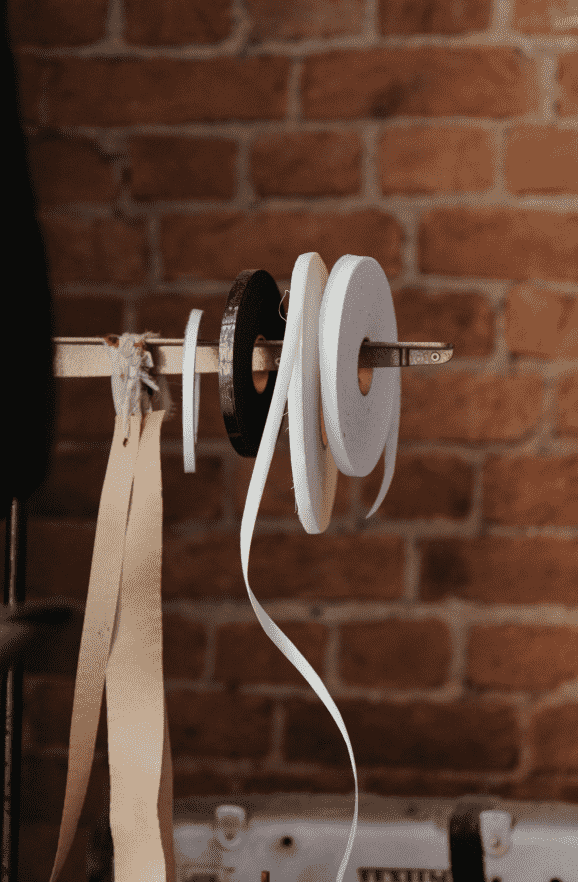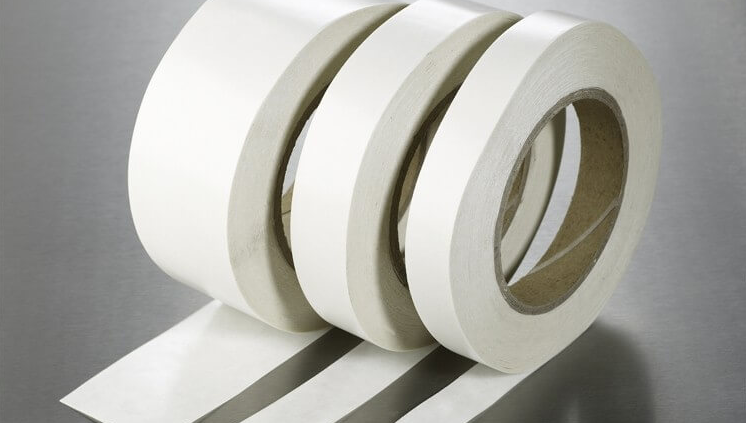What is double-sided tissue tape used for?
Tissue tapes are versatile, stable and flexible tapes that are used in a variety of applications, including lamination and fixings. Double-sided tissue tapes are coated with adhesive on both sides and are useful for binding two surfaces together. They are permanent, quick-bonding tapes which provide a clean and dry alternative to glue. Being hand-tearable, these are highly convenient tapes to use in a range of industries and situations.
What Is Double-Sided Tissue Tape?
This is a lightweight tissue or tissue paper tape that has been coated with adhesive on both sides and laminated with release paper. The tissue is non-woven and the adhesive can be either modified acrylic or rubber resin hotmelt, both of which provide high-tack, weatherproof bonding.
The heavy-duty double-sided tissue tapes in our range are suitable for indoor and outdoor use and have a wide range of applications across many industries.
What is Double-sided Tissue Tape used for?
While many people come across tissue tape in their work, they may not realise that the product has many varied uses. This versatile, lightweight tape is equipped with strong adhesive to provide immediate and lasting bonding. But what can I use tissue tape for? Here we list some of the many uses for double-sided tissue tape.
Seal Packaging

Tissue tapes with a rubber resin hotmelt adhesive are widely used for sealing boxes, packets and envelopes. The strong adhesive bonds well to card and paper, ensuring your products can’t be opened without leaving clear signs of tampering, perfect for eCommerce businesses. Look for finger lift varieties for quick and easy removal of the backing tape.
Layer up paper and card mounts for framing. Using tissue tape, you can mount photographs, textiles or other lightweight objects with little mess or fuss. Double-sided tissue tape can also be used to laminate paper, plastic and textiles, creating a strong, long-lasting surface.
Fitting Carpets, Rugs and Stair Treads

The adhesive on these tapes is so strong and durable that it can be used to hold furnishings to floors, even in areas that are walked over continually. The tape can hold down carpet edges, keep rugs in place and fix anti-slip stair treads to steps.
Insulation
Another use for tissue tape is to attach insulation to walls. If you are trying to increase the energy efficiency of your home, one quick fix is to use this tape to fix reflective insulating material to the walls behind radiators.
This stops heat from being lost through the wall, as it is reflected into the room. Simply cut the reflector to the right size, apply a strip of tape along the top edge, and slide it down behind the radiator. Then peel off the backing paper and press to the wall. The tape will bond the reflective material to the wall quickly.
You can also use this tape to hold pipe insulation in place, by applying a strip to the length of the pipe, removing the backing and wrapping the insulation around it. Foam insulation boards, which are great for unfinished walls, floors and ceilings, can also be fitted easily with double-sided tape.
What are the benefits of double-sided tissue tape?
- This kind of tape is particularly useful in many industries and has many benefits.
- Economical choice for builders, DIY and retrofit experts. This tape is much cheaper than many other adhesives on the market and saves you time as well.
- Good adhesive strength, avoiding having to reapply new tape over time.
- Hand-tearable so you don’t have to muck about with scissors or blades. This makes it much easier to measure by direct comparison as you can simply rip the length away.
- Immediate bonding means that the tape adheres quickly to any surface. There is no drying time, making many household jobs quicker and more immediate.
- Weatherproof tape can be used outside and in, helping make outdoor work more efficient.
- No mess as with glues or liquid adhesives. The only thing to clear up is the backing paper.
How to use double-sided tissue tape

This tape is good for temporarily fixing two surfaces together, e.g. holding down rugs on slippery floors. Apply the tape to the edges of the item to be fixed. Peel off the release paper or film to leave a layer of glue-coated tissue behind. Press the item to the surface firmly.
Tips:
- Apply to clean surfaces. Clean surfaces before applying the tape so that the adherent is not covered with dust, dirt or lint. This will affect how well the tape sticks to the surface.
- Avoid Heat. Do not use it directly on hot surfaces as the adhesive may melt and lose its ability to stick. If you are using this kind of tape on surfaces near heat sources, such as installing insulation behind radiators, be aware that it may not be as long-lasting as in other applications
- Choose the right size. Tissue tapes come in various sizes, so measure well and ensure you use an appropriate width of tape for the job.
Frequently Asked Questions
In this FAQ section, we will answer some of the most commonly asked questions about double-sided tissue tape, including properties, industrial uses, and best practices.
Is tissue tape removable?
Because of its strong bonding capabilities, double-sided tissue tape is not designed to be removed or repositioned. Ensure you apply the tape carefully and avoid using it on fabrics, wallpaper or paint in visible areas if it is likely to need removing.
Is tissue tape permanent?
Tissue tapes using a rubber resin hotmelt adhesive are designed to provide permanent bonding. In some cases, where tissue tape is used on very hot surfaces, the bond may be compromised and lose stickiness.
Tissue tapes which use a water-based modified acrylic adhesive are also designed to be long-lasting, though may lose strength after one to two years.
Is tissue tape waterproof?
Yes, tissue tapes with both rubber resin hot melt and water-based modified acrylic adhesives are water resistant. The bonds these adhesives create cannot be dissolved once applied. This makes them excellent choices for indoor and outdoor use.
What industries use double-sided tissue tape?
Double-sided tissue tape is used in many industries, including but not limited to shoe-making, leather, paper, white goods, eCommerce packaging, postal, and carpet-fixing.
What other types of double-sided tape are available?
Double-sided tapes are useful because they help bond two surfaces together quickly and with little mess, for a reliable, permanent bond. At Kirkfield Rubber & Adhesive Products, we manufacture and supply a range of double-sided tapes for industrial, eCommerce and personal use. As well as tissue tape, the types of double-sided tapes we provide are:
Acrylic Tape – Tape with acrylic adhesive, providing stable, weatherproof bonding even at extreme hot or cold temperatures and high humidity.
Hot-Melt Coating – These tapes provide an immediate bond and remain highly flexible on application.
Scrim Double-sided Tape – a reinforced transfer tape to provide extra strength, suitable for plastering, automotive, foam and rubber industries.
How to remove double-sided tape?
While the double-sided tapes we supply are intended to be permanent, accidents happen and occasionally we need to remove the tape. There is no guarantee that you will be able to remove double-sided tapes that are designed for permanence, and depending on the adhesive type, attempting to remove double-sided tape can damage the surface.
If you do apply tape to the wrong area, attempt to remove it as soon as possible with warm water, a sponge, and a knife.
Water-based acrylic adhesive: This type of glue forms a permanent bond once its water content has evaporated, so acting quickly is important. Use a sponge to wet the area completely and attempt to peel back the tape. You could use a knife or scraper to push the adhesive away from the surface.
Rubber resin hot-melt adhesive: It may be possible to remove hot-melt adhesive tapes with heat, but the temperatures required for this are not domestically achievable and are likely to damage the surface.
It is important to emphasise that these tapes are designed to be permanent, and attempts to do so will cause damage. It is better to be over-prepared and only apply to the intended locations when absolutely certain.




